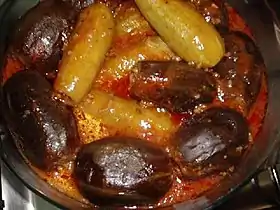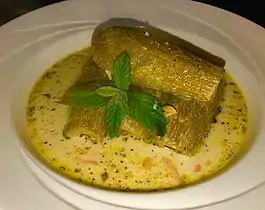 | |
| Type | mahashi (stuffed vegetables) |
|---|---|
| Region or state | Middle East |
| Main ingredients | zucchini · minced meat · eggs · olive oil · onion · pine nuts · yogurt · starch (to thicken the yogurt sauce) |
| Similar dishes | kousa mahshi |
Sheikh al-mahshi (شيخ المحشي Arabic pronunciation: [ʃeːx.al.maħʃi] 'the Chief of fillings'), sheikh el mahshi or shexmahshi (Kurdish) is a popular dish in the Middle East consisting of eggplant or zucchini stuffed with minced lamb meat and nuts, bathed in a yogurt sauce (the original) or tomato sauce (derivative).[1][2][3] It is also known as محشي الكوسة باللبن ('stuffed zucchini with yoghurt').[4] [5] Certain sources point to Syrian origin,[6]
Due to its combination of flavors and laborious preparation, this is one of the most appreciated dishes in the Arab world.[6] This esteem is reflected in its name: sheikh means 'chief', that is, it is considered a "sheikh's food".[7] Unlike kusa mahshi, the filling completely dispenses with rice, and is instead filled with more luxurious ingredients: meat and pine nuts. This dish requires a lot of elaboration, which is why it is considered an honor for guests when it is served in a house.[8]
Popular legend has it that this dish was found in Syria and the dish spread throughout the Middle East, the Arabs gradually replaced the vegetable filling with meat and onion.[9] zucchini is more commonly used in Iraq, Syria, Palestine, Jordan, Egypt and the Gulf countries, while in Lebanon eggplants are preferred.
Preparation
In general, small vegetables are used, since large ones are difficult to seed, and require a lot of stuffing.[10] If only large ones are available, it is better to cut them in half. Although less well known, there are also recipes that use tomatoes.[11]
The filling begins by lightly toasting the almonds or pine nuts. In addition, a chopped onion is cooked over low heat. Then the minced meat is added and seasoned with the spices to suit each home: cinnamon, black pepper, etc. and salt. Finally, the meat is mixed with the dried fruit.
In the Middle East there is a specific kitchen utensil for emptying vegetables, called in Arabic حفارات الكوسا (hafarat kusa, or ma2warah) and "sacacorazones" in Spanish. With another utensil there is a risk of breaking the skin of the vegetable and therefore making it unusable.[12]
Once all the zucchini have been emptied, they are stuffed. Finally, the zucchini are lightly browned in samneh.
For the yogurt sauce, flour should be mixed with strained yogurt and water, and heated in the pot without stopping stirring, which is difficult. First-time cooks are advised to add egg or an egg-flour mixture to help stabilize the sauce and keep it from splitting.[12] Starch can also be used to thicken it. Finally, the stuffed zucchini are placed in the yogurt sauce and cooked. The dish is commonly served with rice.
- Variants
 Sheikh al-mahshi of zucchini and aubergines in tomato sauce
Sheikh al-mahshi of zucchini and aubergines in tomato sauce Sheikh al-mahshi of zucchini in yogurt sauce
Sheikh al-mahshi of zucchini in yogurt sauce
See also
References
- ↑ Sageer, Julie Ann (2017). Julie Taboulie's Lebanese kitchen : authentic recipes for fresh and flavorful Mediterranean home cooking. Leah Bhabha, Alexandra Grablewski (1st ed.). New York: St. Martin's Publishing Group. pp. 101. ISBN 978-1-250-09493-3. OCLC 957021040.
- ↑ Osborne, Christine (1988). An insight and guide to Jordan. New York: Hippocene. ISBN 9780870524653. OCLC 1035673384.
- ↑ Laird, Mary Louise (1995). Lebanese mountain cookery (1st ed.). Boston: D.R. Godine. pp. 159. ISBN 1-56792-020-9. OCLC 30915162.
- ↑ Almaani, Fidaa (2021-02-13). "طبق شيخ المحشي الشهي" [The delicious Sheikh Al-Mahshi dish]. الامنيات برس (Alumniyat Press) (in Arabic). Retrieved 2021-09-08.
- ↑ حماد Hammad, رويدا Rowaida (15 October 2020). "شيخ المحشي" أصوله و طريقة تحضيره"" [Sheikh Al-Mahshi, origins and method of preparation]. سكلوز (Sakaluz) (in Arabic). Retrieved 2021-09-08.
- 1 2 شورى Shura, حسام Hossam (2019-05-07). "تاريخ الطعام (2) : بالرغم من اختلاف المكونات.. أصل المحشي ليس مصريًا" [History of food (2): Despite the different ingredients, the origin of the mahshi is not Egyptian]. خدمات الشروق (Khadamat al-Shuruq) (in Arabic). Retrieved 2021-09-08.
- ↑ Khan, Yasmin (2019). Zaitoun: recipes from the Palestinian kitchen. Matt Russell, Raya Manaa'and, Hosam Salem (1st ed.). New York: W. W. Norton & Company. pp. 300. ISBN 978-1-324-00263-5. OCLC 1084726066.
- ↑ Farsoun, Samih K. (2004). Culture and customs of the Palestinians. Westport, Conn.: Greenwood Press. pp. 66. ISBN 0-313-32051-9. OCLC 55679550.
- ↑ Salah, Jamal (2013). "Sheij el mahshi, el jeque de los rellenos". El Cucharón en la Sopa (in Spanish). Retrieved 2021-09-08.
- ↑ Nader, Ralph (2020). The Ralph Nader and family cookbook : classic recipes from Lebanon and beyond. Brooklyn, New York: Akashic Books. pp. 143. ISBN 978-1-61775-828-7. OCLC 1149091201.
- ↑ Roden, Claudia (2008). "Sheikh el Mahshi Banadoura". The new book of Middle Eastern food. New York: Alfred A. Knopf. pp. 319. ISBN 978-0-307-55856-5. OCLC 430828581.
- 1 2 Saleh, Maha (2016-10-30). "Sheyj al-mahshi". Monitor De Oriente (in Spanish). Retrieved 2021-09-08.